I wanted to see if I could document the majority of the actions to account for the Air to Sea actions in the Pacific that could have potentially been used to build up a database of facts about how effective various platforms were and the efficacy of those platforms against ships.
Why? It seems to be that most games I have tried to date have not really been able to capture what we could call historical loss rates, either across a campaign or for any specific scenario. My suspicion or contention is that there just is not enough data to support a robust combat set of mechanics, nor enough data to build a normal distribution. The second compounding factor is luck, or lack of it. The Pacific battles are rife with examples and stories of the good/bad luck striking at just the right or wrong moment.
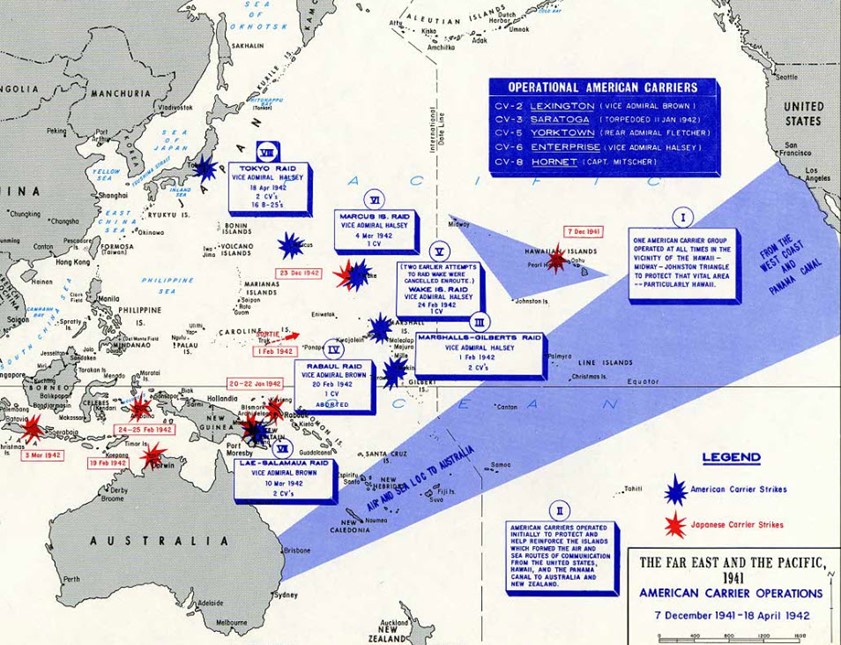
So I decide to try and grab as many of the details I could from online and other sources about actual Air to Sea actions where ships were sunk. There were bombing runs and sorties against the British Navy at the opening of the war. Still looking for that detail, but no solid sources to add to this just yet. Lets pick up the search after Peral as it was a in port event.
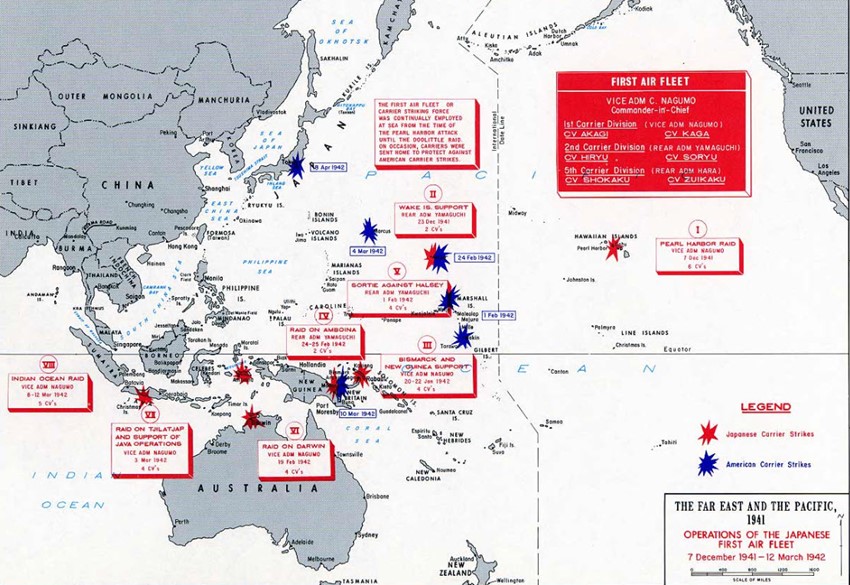
15 Feb 1942
Cruiser Exeter comes under attack by B5N in the Gaspar Strait. She was not sunk by aircraft.
20 Feb 1942
Pacific Ocean
A Japanese H6K flying boat piloted by Lieutenant (jg) Noboru Sakai spotted a US carrier force 460 miles northeast of New Britain; US pilot Jimmy Thatch of USS Lexington shot down Sakai’s aircraft at 1112 hours, but not before Sakai had alerted others.
At 1202 hours, Burt Stanley and Leon Haynes shot down another H6K aircraft, flown by Warrant Officer Kiyoshi Hayashi, north of Lexington. At 1420 hours, 17 Type 1 bombers of Japanese 4th Air Group, led by Lieutenant Masayoshi Nakagawa, were launched from Rabaul, with the first wave reaching Lexington at 1625 hours. The first wave of 9 bombers were all shot down without causing any damage to Lexington; Nakagawa tried to crash into Lexington as he fell from the sky, but fell short by less than 1 mile).
The second wave attacked USS Lexington and USS Minneapolis at 1705 hours, still causing no damage; Edward “Butch” O’Hare shot down 3 and damaged 4 Japanese bombers. Only 2 Japanese bombers arrived back at Rabaul at the end of the day; 100 Japanese bomber crewmen were lost during the attacks, and Japan also lost 20 men with the H6K reconnaissance flights earlier in the morning. O’Hare was given credit for 5 kills, making him an “Ace in a Day” and setting him up for a Medal of Honor award. ww2dbase [Lexington (Lexington-class) | CPC]
2 May 1942
On the morning of 3 May, TF 11 and TF 17 were some 100 miles (161 km) apart, engaged in fueling operations. Shortly before midnight, Fletcher received word from Australian-based aircraft that Japanese transports were disembarking troops and equipment at Tulagi in the Solomon Islands. Arriving soon after the Australians had evacuated the place, the Japanese landed to commence construction of a seaplane base there to support their southward thrust.
Yorktown accordingly set course northward at 27 knots (50 km/h; 31 mph). By daybreak on 4 May, she was within striking distance of the newly established Japanese beachhead and launched her first strike at 07:01―18 F4F-3 Wildcats of VF-42, 12 TBD Devastators of VT-5, and 28 SBD Dauntlesses from VS and VB-5. Yorktown‘s air group made three consecutive attacks on enemy ships and shore installations at Tulagi and Gavutu on the south coast of Florida Island in the Solomons. Expending 22 torpedoes and 76 1,000-pound (450 kg) bombs in the three attacks, Yorktown‘s planes sank the destroyer Kikuzuki, three minesweepers and four barges. In addition, Air Group 5 destroyed five enemy seaplanes but lost two F4F Wildcats (the pilots were recovered) and one TBD Devastator (whose crew was lost). It is unclear here how many were Air to Sea vs Air to Anchored ship.
[ https://en.wikipedia.org/wiki/USS_Yorktown_(CV-5) ]
7 May 1942
Pacific Ocean Coral Sea
At Coral Sea, Japanese carriers attacked US oiler Neosho and destroyer Sims thinking they were a carrier and cruiser, while US carriers attacked escort carrier Shoho and nearby cruisers and destroyer thinking it was part of the main carrier force. At 1747 hours, 12 Japanese dive bombers and 15 torpedo bombers in search of the US carrier fleet was intercepted by 11 US fighters; 9 Japanese and 3 US aircraft were destroyed during the subsequent engagement. At the end of the day, both sides decided against a night battle and prepared for new attacks at dawn. ww2dbase [Battle of Coral Sea | Coral Sea | CPC]
USS Astoria covered USS Yorktown during the Battle of the Coral Sea. ww2dbase [Astoria (New Orleans-class) | Coral Sea | CPC]
Shoho sank in the Coral Sea at 1135 hours after an hour-long carrier aircraft attack that saw 13 bomb and 5 torpedo hits; 631 were killed, 203 survived. ww2dbase [Shoho | Coral Sea | CPC]
USS SKipjack attacked a Japanese transport in the South China Sea; all three torpedoes missed. ww2dbase [Skipjack | South China Sea | CPC]
8 May 1942
Pacific Ocean
Between 0907 and 0915 hours, Shokaku was severely damaged by three bomb hits. One tore open the port bow and started a fire in the forecastle. The second struck the end of the flight deck to starboard. The third hit the starboard side of the rear of the island, damaging gun tubs and the mainmast. Large fires broke out. She was able to evade all torpedoes successfully. Escorted by Ushio and Yugure, she was detached and was able to evacuate the battle area at full speed. 108 officers and men were killed by the fires and explosions, and another 40 wounded. ww2dbase [Shokaku | Yugure | CPC]
USS Skipjack attacked a small Japanese convoy, sinking Japanese transport Bujun Maru and damaging transport Taiyu Maru in the South China Sea 140 miles northeast of Cam Rahn Bay, French Indochina; six torpedoes were expended in this attack, three of which found their targets. ww2dbase [Skipjack | South China Sea | CPC]
In the Battle of the Coral Sea, USS Hammann fired on incoming Japanese aircraft and then rescued 500 survivors of the disabled carrier USS Lexington. ww2dbase [Battle of Coral Sea | Hammann | Coral Sea | CPC]
Portland took aboard 929 survivors of the stricken carrier USS Lexington (Lexington-class) in the Battle of the Coral Sea ww2dbase [Battle of Coral Sea | Portland | DS]
2 Jun 1942
Pacific Ocean Midway
USS Yorktown made rendezvous with USS Enterprise and USS Hornet 350 miles northeast of Midway. Rear Admiral Fletcher took overall tactical command of this fleet. ww2dbase [Yorktown (Yorktown-class) | CPC]
USS Enterprise made rendezvous with USS Yorktown and USS Hornet 350 miles northeast of Midway. Rear Admiral Fletcher took overall tactical command of this fleet. ww2dbase [Enterprise | CPC]
USS Hornet made rendezvous with USS Yorktown and USS Enterprise 350 miles northeast of Midway. Rear Admiral Fletcher took overall tactical command of this fleet. ww2dbase [Hornet (Yorktown-class) | CPC]
US Navy deployed 25 submarines west of Midway in an attempt to detect the incoming Japanese fleet, while Midway-based US Army B-17 bombers attacked Japanese transports 600 miles west of the atoll, inflicting no damage. ww2dbase [Battle of Midway and the Aleutian Islands | CPC]
3 Jun 1942
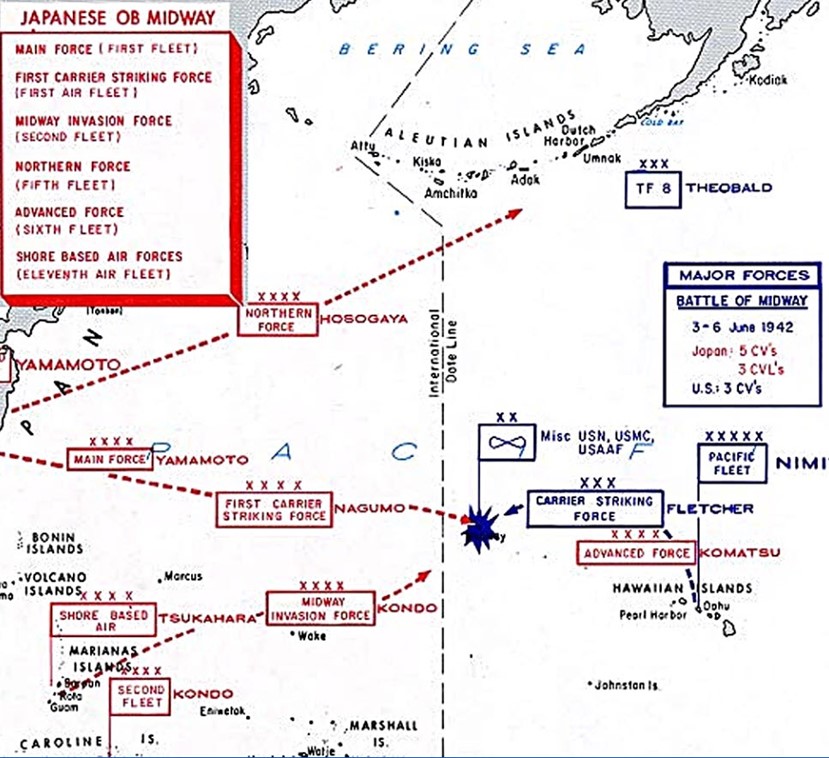
Pacific Ocean
In the morning, US PBY Catalina aircraft discovered the location of the Japanese transports west of Midway Atoll. At 1230 hours, nine Midway-based B-17 bombers launched from Midway, reaching and attacking Japanese transports 660 miles to west at 1830 hours, inflicting no damage; meanwhile, US Navy Task Forces 16 and 17 changed course in an attempt to gain a more favorable battle for the upcoming battle.
On the Japanese side, submarines arrived to form a cordon to detect American warship movements from the Hawaii Islands toward Midway Atoll; they did not realize that the American carriers had already passed. [Battle of Midway | CPC]
Light carrier Hosho sailed ahead of the Southern Force into the Midway area. ww2dbase [Hosho | CPC]
4 Jun 1942
Pacific Ocean Battle of Midway
Akagi launched strikes against Midway Atoll. She was subsequently attacked by numerous enemy land and carrier-based aircraft. At 1026 hours, she was attacked by three aircraft from USS Enterprise, suffering one direct hit amidships in the vicinity of the island, starting a fire in the hangars. A second hit ripped through the fantail and exploded under the port quarter. The third bomb released at her was a near-miss port-side forward. Although normally the damage would had been moderate, the vessel was currently engaged in preparing a strike, with the result that the single bomb hit induced explosions among armed and fueled aircraft within hangars and start a raging aviation gasoline fire. Since she was in a maximum turn at the time, Akagi’s rudder was damaged, and soon jammed at 20 degrees to port, leaving her going in wide circles. Unable to command the fleet from her now, at 1046 hours Vice Admiral Chuichi Nagumo transferred flag first to Nowaki, then to Nagara. Akagi’s engines worked erratically, with the ship starting and stopping, but she went dead in the water for good at 1350 hours. By 1600 all non-essential personnel had left the ship, though Captain Aoki and a damage control party remained aboard. The vessel burned through the evening and next night, but remained afloat. ww2dbase [Akagi | CPC]
Light carrier Hosho’s aircraft located the burning wreck of carrier Hiryu off Midway Atoll. ww2dbase [Hosho | CPC]
Kaga was struck by at least four bombs during the Battle of Midway and suffered a great fire. She was scuttled at 1925 hours by two torpedoes from destroyer Hagikaze. 814 were killed in her loss. ww2dbase [Kaga | CPC]
Starting at 0700 hours, US carriers launched torpedo bombers and dive bombers against the Japanese fleet in the Midway region. Japanese carriers wiped out the first few waves of US air attacks, but at about 1030 hours dive bombers were able to hit Soryu, Kaga, and Akagi.
USS Yorktown was hit by Japanese dive bombers at about 1200 hours and by torpedo bombers at 1440 hours, forcing Rear Admiral Fletcher to transfer his flag to cruiser Astoria. At 1703 hours, the last undamaged Japanese carrier Hiryu was hit by a dive bomber. Soryu would sink at 1913 hours (711 were killed, 392 survived), and Kaga would be scuttled at 1925 hours (811 were killed, 900 survived). ww2dbase [Battle of Midway and the Aleutian Islands | CPC]
In the Battle of Midway, USS Hammann shot down two Japanese aircraft attacking USS Yorktown, but nevertheless Yorktown would be disabled by the Japanese. Hammann rescued about 500 survivors from Yorktown. ww2dbase [Battle of Midway and the Aleutian Islands | Hammann | CPC]
Jack Kleiss, flying a SBD Dauntless dive bomber, scored bomb hits on Japanese carriers Kaga and Hiryu off Midway Atoll. ww2dbase [Battle of Midway and the Aleutian Islands | Jack Kleiss | CPC]
Pilot Eugene Lindsey and gunner Charles Grenat were killed off Midway Atoll when their TBD Devastator aircraft was shot down by Japanese A6M2 Zero fighters while attacking carrier Kaga. ww2dbase [Battle of Midway and the Aleutian Islands | Gene Lindsey | CPC]
Yugure escorted the Aleutian Guard Force. ww2dbase [Battle of Midway and the Aleutian Islands | Yugure | CPC]
5 Jun 1942
Pacific Ocean
Akagi was scuttled by direct order of Combined Fleet chief Admiral Isoroku Yamamoto. At 0520 hours, she sank bow first after two or three torpedo hits out of four fired into her starboard side by Arashio, Hagikaze, Maikaze and Nowaki. She sank in position 30-30 N, 178-40 W. More than 1,070 survivors were rescued, including her skipper Taijiro Aoki, who had replaced Hasegawa in the spring, though he had to be ordered off the ship. Only 263 petty officers and men were lost. Survivors were subsequently transferred from destroyers to Mutsu, one of the battleships in Yamamoto’s Main Body. Akagi became the first Japanese capital ship to be scuttled by own ships in the Pacific War. ww2dbase [Akagi | CPC]
At 0015 hours, Yamamoto ordered the night engagement at Midway to be canceled; at 0255 hours, he ordered the entire Operation MI to be canceled. In the battle zone, heavily damaged Japanese carriers Akagi and Hiryu were scuttled. To the west, heavy cruisers Mogami and Mikuma suffered a collision as they attempted to avoid submarine USS Tambor; Mogami suffered 92 killed and heavy damage in the collision. Far to the north, in the Aleutian Islands, aircraft from Japanese carriers Ryujo and Junyo attacked Dutch Harbor, US Territory of Alaska as Japanese troops occupied Attu. ww2dbase [Battle of Midway and the Aleutian Islands | CPC]
Portland took aboard 2,046 survivors of the stricken carrier USS Yorktown (Yorktown-class) in the Battle of Midway ww2dbase [Battle of Midway and the Aleutian Islands | Portland | DS]
Tanikaze was ordered to search for the disabled carrier Hiryu and to rescue survivors, but she was not able to find Hiryu (which already sank). Tanikaze was in turn attacked by 32 US Navy dive bombers. One of the five near-misses caused an explosion in the after turret, killing six. ww2dbase [Battle of Midway and the Aleutian Islands | Tanikaze | CPC]
Jack Kleiss, flying a SBD Dauntless dive bomber, dropped bombs on Japanese destroyer Tanikaze off Midway Atoll, but the bomb missed. ww2dbase [Battle of Midway and the Aleutian Islands | Jack Kleiss | CPC]
Japanese cruiser Kumano was leading a column of sister Mogami-class cruisers Suzuya, Mikuma, and Mogami withdrawing from Midway. Kumano spotted the surfaced American submarine USS Tambor and ordered an emergency 45-degree turn to starboard, but Mikuma mistakenly made a 90-degree turn. Mogami rammed Mikuma on the portside below the bridge crumpling 40-feet of Mogami’s bow and piercing Mikuma’s fuel tanks, causing her to leak oil uncontrollably. This trailing oil slick led to Mikuma’s demise the following day. ww2dbase [Battle of Midway and the Aleutian Islands | Mogami | Mikuma | Suzuya | Kumano | Tambor | DS]
Yugure escorted the Aleutian Guard Force. ww2dbase [Battle of Midway and the Aleutian Islands | Yugure | CPC]
Pacific Ocean
Portland screened carrier USS Enterprise during the Battle of the Eastern Solomons ww2dbase [Solomon Islands Campaign | Portland | DS]
Kumano screened the carrier Ryujo and the battleship Kirishima in the Battle of the Eastern Solomons and against an attack from B-17 bombers. ww2dbase [Solomon Islands Campaign | Ryujo | Kirishima | Kumano | DS]
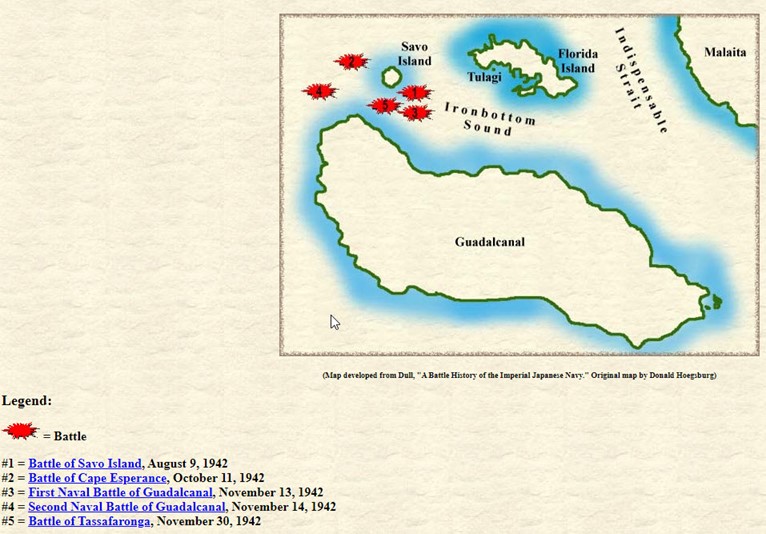
Savo Island, Cape Esperance, and Guadalcanal were all primarily ship to ship engagements, and provided a major turning point in the war for the Allies.
http://www.combinedfleet.com/battles/Guadalcanal_Campaign#Second_Guadalcanal
25-27 Oct 1942
Pacific Ocean
Yamamoto’s second attempt to achieve naval superiority in the area around Guadalcanal came in late October. Shokaku and Zuikaku again formed the core of Combined Fleet’s carrier forces, although Zuiho was along for the ride as well. And again, Yamamoto divided his forces into a van, main body, and a plethora of weak and mutually non-supportive support groups (oxymoron intended).
The Americans got their licks in early, punching a 50-foot hole in Zuiho’s flight deck and sending her back to Truk. However, the Japanese put together a very effective attack against Hornet which left her dead in the water. Enterprise and several other American ships were also damaged. Several attacks later in the day crippled Hornet beyond repair, and as attempts to tow her had proved futile, she was abandoned. An American counterattack had badly damaged Shokaku, necessitating her withdrawal, and both the Japanese and the Americans quit the field soon thereafter. American losses had been more serious, but again they had managed to stave off the Japanese efforts to nullify Henderson Field.
USS Hornet (Yorktown-class) was lost during the naval Battle of Santa Cruz. ww2dbase [Solomon Islands Campaign | Hornet (Yorktown-class) | TH]
23-25 August 1942
The first major carrier battle over the Solomons occurred shortly after the American landings. The Japanese realized that reinforcements were desperately needed on the island. Simultaneously, they needed to knock out the American airbase at Henderson Field, which was quickly becoming a menace to Japanese shipping in the area. Consequently, Admiral Yamamoto put together a powerful expeditionary force whose aim was first to destroy any American fleet units that might be in the area, and then eliminate Henderson Field. This force sortied from Truk on August 23rd. Simultaneously, several other reinforcement, support, and bombardment groups sortoed from both Truk and Rabaul.
The Americans would have had three carriers with which to meet the Japanese force, but Wasp was detached to refuel on the 23rd, so she would be out of the coming action. Thus, the Americans would field two carriers (Saratoga and Enterprise) and 176 aircraft to the Japanese two heavy carriers (Shokaku, Zuikaku) and one light carrier (Ryujo) and 177 aircraft; pretty much a straight-up fight. As he was prone to, however, Yamamoto divided his forces, sending Ryujo off by herself in advance of the main force, ostensibly to be in a position to attack Henderson Field, as well as supporting the Guadalcanal reinforcement convoy under Raizo Tanaka coming down the Slot from Rabaul.
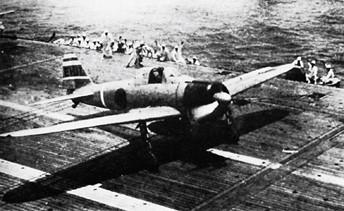
As usual, division of forces cost the Japanese, as the Americans got in the first blow. Catching Ryujo by herself, and with most of her fighters either gone (on a strike against Guadalcanal) or (inexplicably) still on her decks, they quickly turned her into a burning, sinking wreck. The Japanese heavy carriers, however, counterattacked and damaged Enterprise badly with three bomb hits. However, she managed to transfer the majority of her airwing to Henderson Field before limping away to the southeast. A second Japanese strike failed to find the Americans (which meant that Enterprise would live to fight another day). After an abortive attempt to engage the Americans in a night surface fight with battleships and cruisers, the Japanese Main Force began retiring to Truk.
This was a mistake. The Japanese heavy carriers were thus far unscathed, while they had rendered one of the American CVs impotent, thus leaving them with the advantage. Instead, by withdrawing, Yamamoto had left Tanaka’s reinforcement convoy practically unprotected in the Slot. On the morning of the 25th, as the Japanese began approaching Taivu Point, American aircraft from Henderson found the convoy and gave it a pasting. A transport was sunk, and an older destroyer so badly hit that she had to be scuttled. Several other warships were damaged. At this point, Tanaka wisely withdrew.
The Japanese had an opportunity for a decisive victory and had failed to grasp it. American carrier power in the region was diminished, but not broken. Further, with the installation of Enterprise’s aircraft at Henderson, the American airfield was a more prickly target than ever. This established an operational precedent, as Henderson would be fed a steady stream of carrier-borne reinforcements. Because of American airpower, the waters around Guadalcanal would continue to be a very dangerous place during the daylight hours.
1943
Saw much of the wars action take place in the Solomon Islands North West of Guadalcanal and in and around Rabaul. Which were primarily Ship to Ship battles, except where noted.
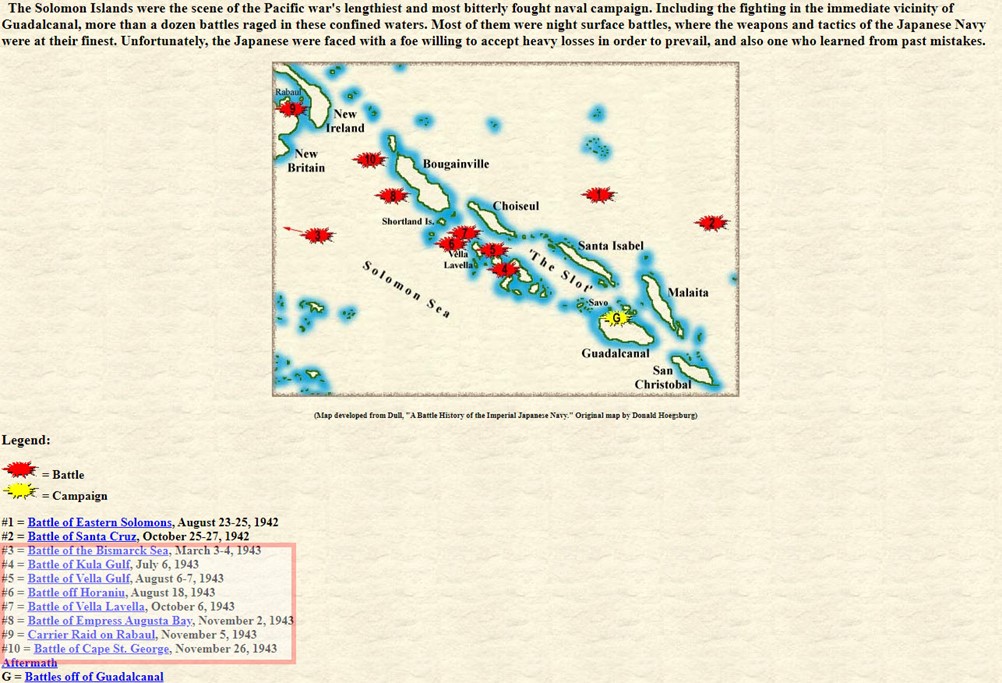
3-4 Mar 1943 Battle of the Bismark Sea
At the same time as the Guadalcanal campaign was raging, an equally bitter series of battles was occurring on the island of New Guinea. In early march, a convoy set out from Rabaul to land much-needed reinforcements in the Buna – Gona area. It was composed of eight transports escorted by eight destroyers, and screened by an inadequate light combat air patrol.
Unbeknownst to the Japanese, the American air force had been experimenting with a new aerial tactic called skip-bombing, wherein the attacking airplane drops a bomb with a long-delay fuze close to the surface and lets it skip into the side of the target ship. This was the first occasion in which the Americans would use this new tactic. As soon as the Japanese came under the radius of American airpower, the convoy was attacked relentlessly. The first day’s attack (by high altitude B-17s) sank two transports and damaged a third. Two destroyers were tasked with rescuing the survivors and making a high speed run to New Guinea to deposit them. This they did, and returned to the plodding convoy before dawn the next day.
March 4 proved to be a disaster for the Japanese. Coming within range of American and Australian medium bombers, the convoy was savaged by skip-bombing and strafing. By noon, all six remaining transports and four of the destroyers were sinking or sunk. The remaining four destroyers recovered what few survivors they could and fled north to Rabaul. After this, the Japanese would never again attempt to run slow transports into the face of American airpower. 120 Aircraft took part losses are not known, but as stated above skip bombing was used to great effect.
Note that the Carrier raid on Rabaul was in November 1943, but was similar in nature to Pearl in that most targets were docked, significant damage was inflicted and only ten aircraft lost.
1944
19-20 Jun 1944 Battle of the Philippine Sea
Once Truk had been eliminated as an effective base, and the Japanese Navy driven from the environs, the Americans could complete their invasions of the Marshall Islands unmolested. Next, they set their sights on the Marianas. From these islands, long-range American B-29 aircraft would have the ability to hit the Japanese Home Islands. The Japanese were well aware of this fact, and planned a Decisive Battle to stop it. Admiral Jisaburo Ozawa’s plan was to use the longer range of his aircraft to good effect by shuttling them between his carriers and the airbases on Guam and Saipan, hitting the Americans coming and going, while keeping his carriers out of range of an American counterstrike.
Unfortunately for Ozawa, the American fleet quickly devastated the Japanese airfields in the area, meaning that Ozawa’s flyers would be walking into a buzzsaw when they tried to land. Few of them had a chance to do so, however, as the majority were destroyed attempting to attack the American task forces. Spruance had arranged his warships such that any Japanese aircraft had first to evade a very effective radar-vectored combat air patrol (the US Navy flew more defensive CAP sorties than the Japanese launched in total sorties of all kinds), and then fly directly through the immensely powerful anti-aircraft fire of the screening battleships and cruisers, which had been deployed across the front of the formation in a Gun Line. American technological and pilot superiority were telling, and exacted hideous losses from the Japanese attackers.
Meanwhile, Ozawa was having difficulties with American submarines. Carrier Taiho was torpedoed, and though she took only a single hit, poor damage control technique led to a catastrophic gasoline-fumes explosion which destroyed her. That same afternoon, veteran Shokaku had been sunk by another US sub. Follow-up strikes by American aircraft would also add carrier Hiyo to the list of victims, with several other major warships damaged. The Japanese carrier arm, its carefully rebuilt air groups slaughtered almost to a man, had virtually ceased to exist as an implement of war.
This battle involved a significant number of aircraft both land and Carrier based. Over 956 for the USN and 1600 plus for the Japanese. Losses however were disproportionate with 750 Japanese planes downed for 130 lost. Noteworthy that both IJN carriers were taken out by submarines. The Hiyo was registered as a Air to Surface kill along with others damaged.
https://ww2db.com/battle_spec.php?battle_id=10
24 Oct 1944 Leyte Naval Battles
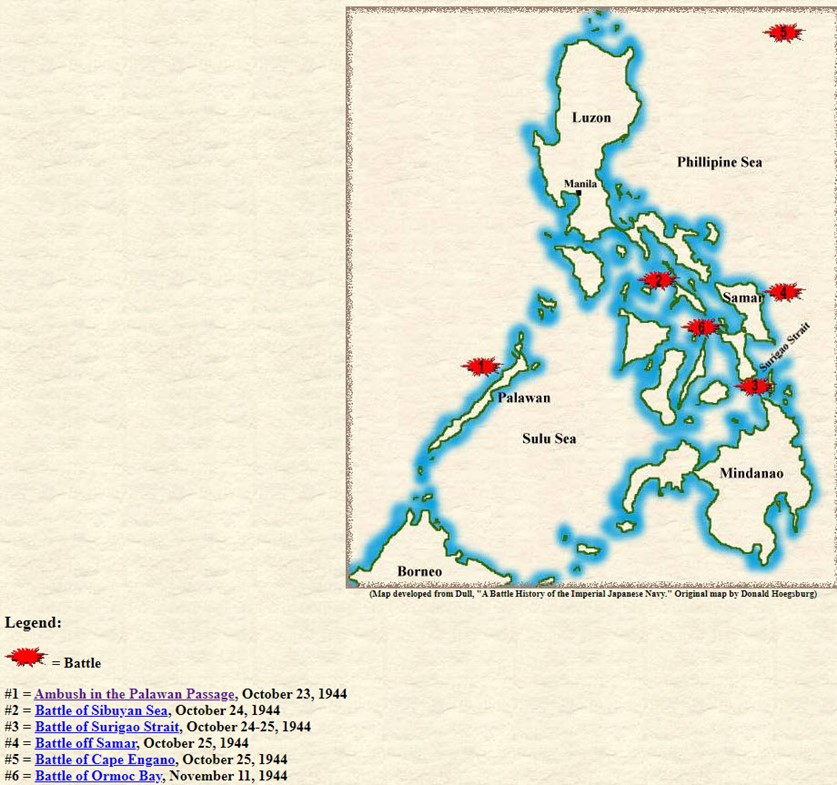
Pacific Ocean Battle of Sibuyan Sea
Kurita’s force made it into the Sibuyan Sea, west of Leyte, the fun really began. American carrier aircraft pounded the group of warships most of the day on the 24th. What little Japanese air cover there was over the squadron was driven off almost instantaneously by the superior American airpower. Most of their attacks were directed at the hapless Musashi, which succumbed to her wounds late in the afternoon after absorbing a staggering amount of punishment (twenty torpedoes, seventeen bombs, and eighteen near misses). Several other vessels received damage as well. Kurita briefly turned his force around to the west to get out of American air range, but then returned to an eastward heading. As luck would have it, the American fast battleship force that might have met him in the San Bernardino Strait that night had been moved northward with Halsey’s carrier forces as he sought to attack Ozawa’s bait force. By dawn Kurita would be off the beaches of Samar, with no one the wiser as to his whereabouts. 1 BB sunk, 2 BB damaged 1 CA sunk and 3x DD damaged.
25 Oct 1944
Japanese forces were attacked by US aircraft but suffered no crippling damage in Surigao strait.
Kurita’s reward for his perseverance the day before was presented to him the morning of October 25th. At 0644 Japanese lookouts spotted masts to the southeast. They belonged to a group of six escort carriers, three destroyers, and four destroyer escorts whose main responsibility was providing airpower for the ground forces on Leyte. This force was part of a larger Task Group consisting of sixteen escort carriers, nine destroyers, and fourteen destroyer escorts divided into three Task Units. Nearest to the attacking Japanese force was TG77.43, or ‘Taffy 3’, the northernmost of the three Task Units that comprised TG 77.4. Not surprisingly, the Americans were in quite a tizzy when the Japanese came over the horizon with four battleships and change, because by all rights their collective gooses were now about to be cooked. None of the American vessels carried anything larger than a 5″ gun, whereas the Japanese had everything up to 18.1″ weapons. Furthermore, the top speed of the American CVEs was appreciably lower than that of even the Japanese battlewagons. All in all, things did not look promising for Old Glory.
Fortunately, the Americans were aided by two factors. First, they did have airplanes on those jeep carriers, albeit airplanes without much in the way of anti-ship ordnance other than torpedos. By 0615, the Americans had launched several hundred aircraft, who proceeded to do everything short of throwing stones to harass the Japanese attackers. Second, the screening DDs and DEs for Taffy 3 were maniacally brave. In one of the great feats of sheer guts in naval history, seven American DDs and DEs charged the entire Japanese squadron, which outgunned them so utterly it beggars the imagination.
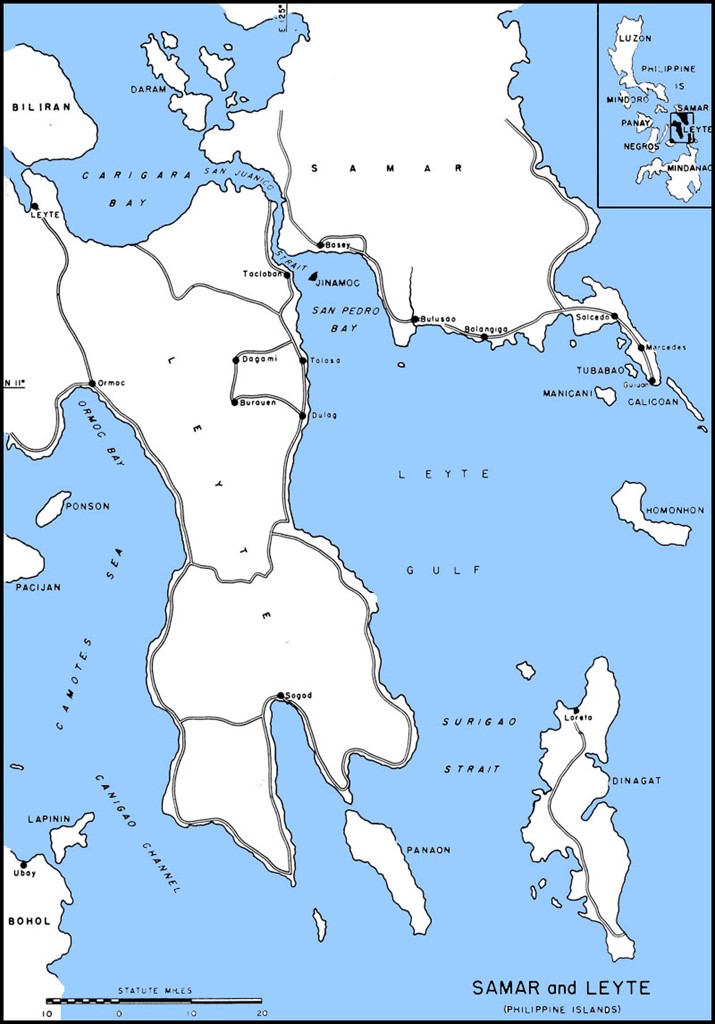
They paid the price, of course. Two DDs and a DE were sunk, but not before they had inflicted appreciable pain on the Japanese, and had convinced Kurita that he was actually up against American fleet CVs with cruiser escorts and all the fixin’s. In the meantime, American aircraft had damaged more of his vessels, forced him to turn away form the battle area several times in Yamato to avoid torpedo attacks, and had completely disrupted his command of the tactical situation. As a result, the Japanese managed to sink only a single jeep carrier before they gave up and turned for home. The remainder of the day brought further air attacks on Kurita’s retreating warships, which would damage still more of them, and sink some of the cripples. Upon arriving in Japan, only Yamato would be truly fit for action. No specific details on Air to Sea kills nor exact numbers on aircraft lost by the US Navy.
Meanwhile, to the north, Admiral Ozawa played out his role to the fullest. Knowing that he and his force would be sacrificed if need be to lure the American heavy units away from the beaches, Ozawa bravely set forth to drag his coattails in front of Halsey. His force of carriers and two hybrid battleship-carriers counted only 108 aircraft between them, a pitiful comment on how far Japan’s naval air arm had fallen. He wasn’t attacked until relatively late in the fight, however. Having received word that Kurita was retiring, Ozawa also turned north for home, but was countermanded by Admiral Toyoda, Commander in Chief of Combined Fleet. Dutifully, Ozawa complied, launching almost all of his planes against Halsey’s TF 38, which was approaching from the south. He kept 13 planes aloft as a combat air patrol, against which the Americans sent several hundred aircraft. The outcome was predictable.
In a day long series of attacks, Halsey destroyed Ozawa’s force, first with aircraft, and then with surface warships sent in to pick off the cripples.
Ozawa’s own aircraft did precious little damage in return, most of them being destroyed by the Americans CAP, and the murderous anti-aircraft Gun Line [57 DD’s] strung out once again in front of TF 38. What few planes did manage to survive and attack found their way to bases in the Phillipines.
This battle is also notable in that the Japanese lost the last of their veteran carriers from Pearl Harbor – Zuikaku (one of my all-time favorites, sniff sniffle). The force Ozawa brought home to Japan in no way resembled the Kido Butai of old. Japan’s carrier air arm was finished. The force disparities here are significant nine CV’s nearly 1100 planes vs 108. A 10 to 1 advantage in all aspects.
http://combinedfleet.com/battles/Leyte_Campaign#Palawan_Passage
19 Mar 1945
Yamato was bombed and eventually sunk on April 7th.
24 & 28 Jul 1945
On 24 and 28 Jul, 1945, Task Force 38 under Admiral Halsey launched two carrier aircraft attacks against what was left of the Japanese fleet, which by now were confined to their home ports due to the combination of the lack of fuel as well as the near-total Allied air superiority. Most of the vessels were destroyed without being able to get underway, and marked the final destruction of the once proud fleet. Once again most of the fleet action here was Air vs docked or stationary ships.
Interestingly not a lot of combat missions to build a data set on that would allow the creation of CRT’s, interception rates kill ratios of Air vs Ship and Ship vs Air.
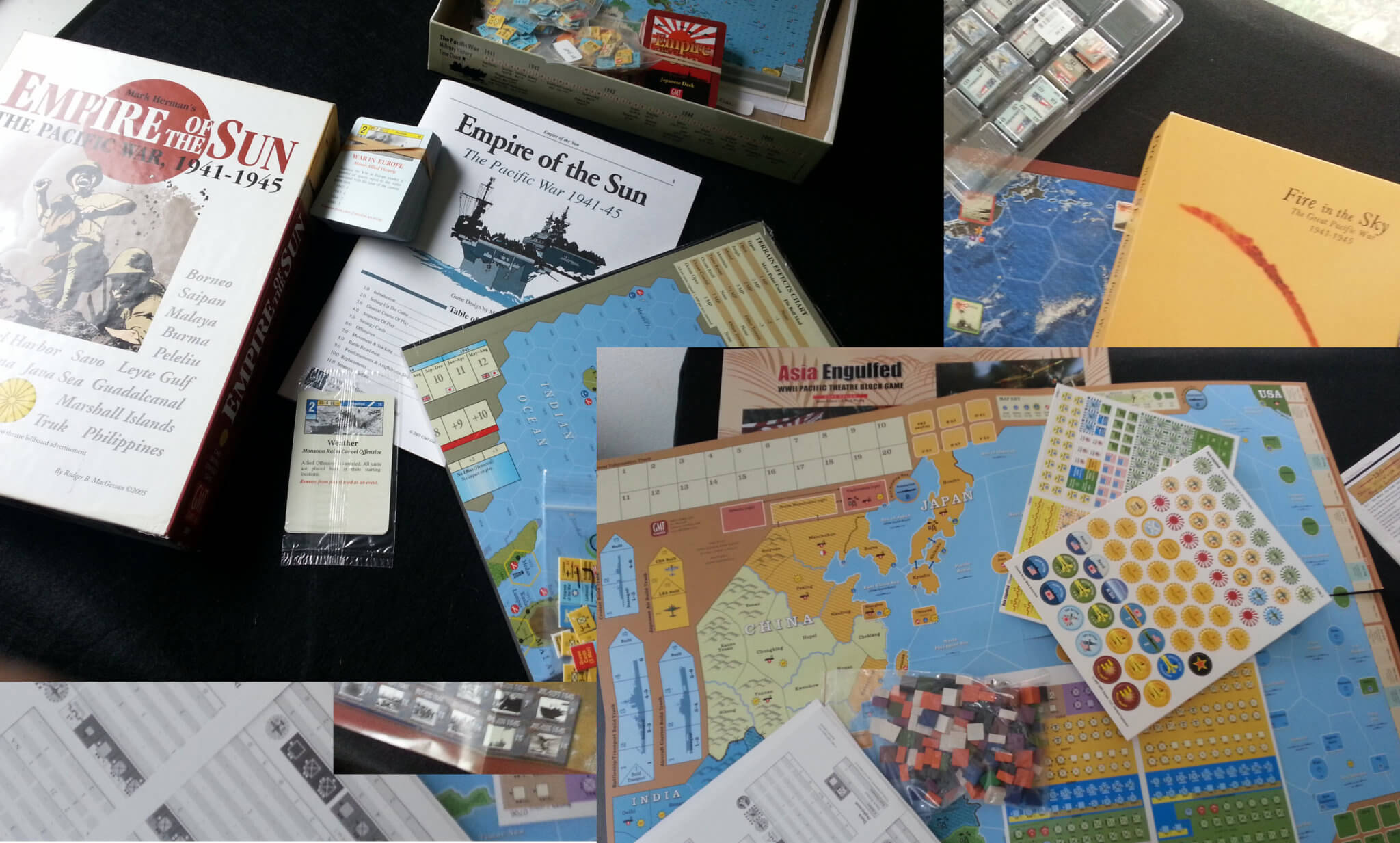
The Bismarck Sea massacre still leavcs me stunned every time I re-read about it. Those were Army twin-engine bombers using skip- and mast-height naval bombing – and they managed to wipe out every transport and half the escorting destroyers in a big convoy with (rather inefficient) fighter cover! In early March 1943 no less! We are not talking about complete US and Allied air supremacy like in late 1944 and 1945. And we are not talking about Navy dive bombers (theoretically much more precise) either.
Great observation!